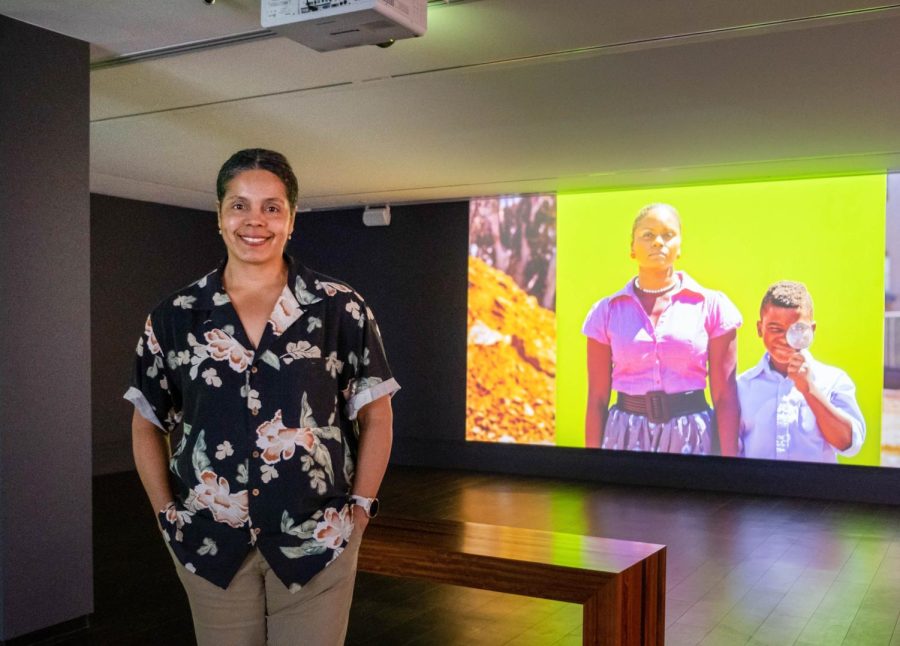UT professor, Art Galleries at Black Studies spotlight Black art, artists, museums on campus
April 20, 2023
Cherise Smith describes the Christian-Green Gallery as a “jewel box” in the middle of campus — small, digestible and accessible.
Each time Smith walks up to the second floor of Jester Center and opens the gallery doors, she feels the same thing: proud.
“Every time I come into this space, I feel proud of the University of Texas (and) of Black studies at the University of Texas,” said Smith, a professor of African and African Diaspora Studies and art history. “This is a beautiful space. I want more people to know about us and to use it.”
Beginning as a UT art history professor in 2005, Smith said she witnessed a lack of on-campus venues centered on Black art and artists. In an effort to bring about change, Smith introduced the Art Galleries at Black Studies in 2016, becoming UT’s sole space dedicated to art and artists from Africa and the African Diaspora. As founding executive director, Smith led the transformation of the Center for African and African American Studies’ former Jester Center location into the Christian-Green Gallery and the Idea Lab within the Gordon-White Building.
Also working as the department chair of African and African Diaspora Studies, Smith researches African American art, the history of photography, performance and contemporary art. Based on her current book project — tentatively titled “Healing Old Wounds” — Smith curated AGBS’s current exhibition, “Old Wounds, Dark Dreams,” featuring artists Charles Gaines, Rodney McMillian, Cauleen Smith and Carrie Mae Weems on view until May 19.
Showcasing artworks such as Gaines’s “Black Ghost Blues Redux” and McMillian’s “Shelter (Crawl),” the exhibition investigates the long-term and complicated effects of racial trauma within the U.S. by utilizing appropriation, which Smith said includes intertextual dialogue where the artists sample or reference other artists’ prior works.
“This is a bit of … a laboratory experiment, where I am able to share the artwork with other people, expand my understanding of it and hear what people think about the work,” Smith said. “It’s really a special treat to have in the works here and be able to engage with people about them.”
During a gallery walkthrough of “Old Wound, Dark Dreams,” Joy Scanlon, the AGBS gallery manager, said she clearly saw Smith’s commitment to intentionality and discussion.
“She really opened up the ground for a conversation,” Scanlon said. “She (wants) to hear how people who are looking at her exhibition think about it, which is … really special.”
Smith said she also finds interest in creative components of curation — how the exhibition looks, how people move through the space and more. In combining both research and creativity, Smith said she uses the culmination of many artworks to create a new work of art.
In addition to showcasing Black art, AGBS fosters discussion through symposiums. Its newest, “Why Black Museums,” begins Friday, April 21 with an inaugural event, “Honoring the Past, Envisioning the Future,” bringing historians and museum directors from around the country to discuss the importance of Black museums historically and presently.
“(AGBS) is special to me because I’ve had the opportunity to conceptualize it, envision it, fundraise for it … and then transform it into this beautiful white box art museum space,” Smith said.
Ilyana Jones, a gallery attendant and African and African Diaspora studies junior, said they believe the work of Smith and AGBS to showcase Black artwork and artists on campus contributes to continued efforts to expand resources and representation for and by the Black community at UT.
“(AGBS) proves that people really care about sharing Black art, Black history, Black stories and Black perspectives,” Jones said. “The fact that it’s on UT campus means it’s accessible to other Black students, brown students and students in general who are interested in learning more.”



